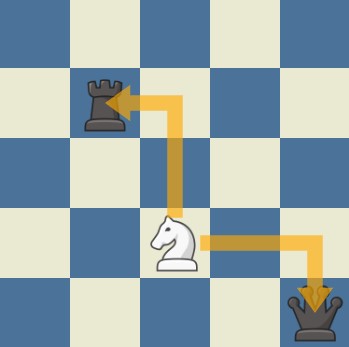Mastering Chess Tactics: The Art of Forking
Today, we’re diving into one of the coolest moves in the chess playbook: forking. Now, you might think we’re talking about dinner table etiquette, but in the chess world, forking is a sneaky tactic that can turn the game in your favor. So, grab your favorite chessboard, and let’s unravel the mysteries of forking!
Imagine this: you move your knight in a way that attacks two of your opponent’s pieces at once. Maybe it’s the king and a rook, or a queen and a bishop. Whatever the combo, it puts your opponent in a tight spot. They can only move one piece to safety, leaving the other one vulnerable to capture. That’s the beauty of a fork—a devious attack that creates a double threat, forcing your opponent into a lose-lose situation.

The Anatomy of a Fork
At its core, a fork involves one piece attacking two or more of your opponent’s pieces simultaneously. Knights are often the stars of forking maneuvers because of their unique L-shaped movement. Picture this: your knight jumping into a spot that puts both the enemy king and queen in check. Your opponent has to move one of them, and boom, you’ve successfully executed a fork.
Spotting the Perfect Moment
Forking isn’t just about the moves you make; it’s about timing and positioning. Look for opportunities when your opponent’s pieces are clustered together or when their important units are on vulnerable squares. Maybe their pieces are in a line, waiting for your knight to pounce. Keep an eye out for these chances, and you’ll be forking like a grandmaster in no time.
Types of Forks
Now, forking isn’t limited to knights. Other pieces can master this art too. Pawns, for instance, can be surprisingly effective forkers. Imagine your pawn advancing, attacking both a bishop and a rook. Your opponent has to choose which one to save, while you gleefully capture the other. That’s a pawn fork in action.
Bishops and queens can also create deadly forks. The key is to look for ways to attack multiple pieces with a single move, forcing your opponent to make tough decisions.
The Psychological Game
Beyond its strategic brilliance, forking plays with your opponent’s mind. It introduces a level of pressure and forces them to make choices under duress. They might make mistakes, especially if they’re not expecting your cunning fork. Use this psychological edge to keep your opponent on their toes, making them more prone to blunders.
Practice Makes Perfect
Like any chess tactic, mastering the fork takes practice. Set up different scenarios on your chessboard, experimenting with various pieces and positions. The more you practice, the better you’ll become at spotting forking opportunities during a real game. Don’t be afraid to make mistakes; each one is a chance to learn and improve your skills.
Conclusion
So, there you have it—a sneak peek into the intriguing world of forking in chess. Remember, it’s not just about moving pieces; it’s about outsmarting your opponent, forcing them into unfavorable positions, and seizing control of the game. With a bit of practice and a keen eye, you’ll be forking your way to victory in no time. Happy playing, and may your forks always be sharp and your opponents forever puzzled!
